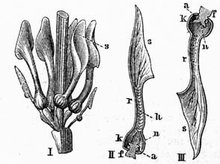Cauldron trap

Kettle traps , or kettle or slide trap flowers , were developed in different kinship groups in the plant kingdom . They emerged from simple flowers . The animals (mostly insects ) caught by cauldron trap lumens are to be forced to pollinate . They are trap flowers like the pinch trap flowers , the flowers of which have a pinch body in which nectar-seeking insects get caught with their proboscis or legs.
Principle and functionality
With the cauldron trap flowers, parts of the flower or the inflorescence are transformed into an almost closed cauldron. Insects are usually carried unpleasant for people smells (for example excrement - or carrion ) lured, color and warmth and slipping most of the slick or oily, waxy interior walls or downwardly facing locking hairs or papillae from the flower, also Türchenmechanismen are possible. At the end of the flower tube inside the flower, the insects end up in a “cauldron” where the pistil is also located.
A locking mechanism usually made of sterile flowers or "trap hair" initially prevents escape. The sterile flowers (obstacle flowers) have individual, strong bristles that can only be bent downwards, or the trap hairs that stand down block the way back so that smaller prisoners cannot simply fly out again. Only when the female flowers are fertilized do the locking bristles and trap hairs wither or slacken and release the exit again. With some Arum species, the flower head grows out of the kettle within a day. The insects use it like a ladder and can thus escape from the cauldron. Opening door mechanisms are also possible.
In the inflorescence of the genus Aronstab ( Arum ) of the boiler is from a bract ( spatha ) is formed. In the candlestick flowers ( Ceropegia ), the overgrown petals form the kettle. In the case of the flowers of the orchid genera Coryanthes , Cypripedium , Paphiopedilum , Phragmipedium , Selenipedium and Mexipedium , the flower lip ( labellum ) is shaped into a "slipper". Lured insects (mostly small bees) fall into the kettle and have to squeeze through a narrow passage behind the shield-shaped column of flowers to get back outside. In doing so, they strip off the pollen that is hidden in the passage.
The flowers of kettle traps are mostly proterogynous , that is, the female organs ripen first and are receptive to pollen. Only when fertilization has taken place do the male flowers or the anthers open and release the pollen. The advantage of this pollination method is that it prevents self-fertilization because the male pollen is only released when the female flower organs have been fertilized.
The principle of the cauldron trap is also used by carnivorous plants , which however do not attract insects for pollination, but to feed on them ( Nepenthes , Cephalotus , Sarracenia , Heliamphora etc.). They form funnel-shaped or kettle-shaped containers made of leaf organs. These are mostly filled with liquid ( phytotelma ) in which the prey drowns. Usually there are hairs or teeth on the edge and in the cauldron, which make it easier to slip and prevent the insects from escaping. Some traps also have wax deposits, which make the surface even more slippery.
Some species are also flowers of deception, such as the spotted arum .
The pollination method of the cauldron trap is very common within certain families or genera , for example:
- Arum family ( Araceae ), example: spotted arum ( Arum maculatum ), titan arum ( Amorphophallus titanum ).
- Easter flower plants ( Aristolochiaceae ), example: pipe flowers ( Aristolochia ).
- Orchids ( Orchidaceae ), Example: lady's slipper ( Cypripedium , Paphiopedilum ) Coryanthes .
- Silk plants ( Asclepiaceae ), example: candlestick flowers ( Ceropegia ).
literature
- Berthold Haller, Wilfried Probst: Botanical excursions. Vol. II: Summer half year , 2nd edition, Springer-Verlag, Berlin 1989, ISBN 978-3-662-48687-0 (reprint), p. 84.
- Fritz Knoll : The biology of the blossom (= understandable science, volume 57 ). Springer-Verlag, Berlin 1956, ISBN 978-3-642-86221-2 (reprint), pp. 93-95.
- Stefan Vogel: The functional types of the Kesselfalle flowers. Institute for Botany at the University of Vienna, In: 9th Conference of the Society for Tropical Ecology, Ulm 17. – 20. March 1999, online at biologie.uni-ulm.de, accessed on September 25, 2018.
Web links
Individual evidence
- ↑ a b c Bernadette Ralser: Caught in the flower media portal Univ. Vienna, November 22, 2012.
- ↑ Manfred Weidner: Fleischfressende Pflanzen (Carnivore): Strategies, Structures, Functions (PDF) on mikoskopie-bonn.de, accessed on September 25, 2018.
- ↑ Carnivore plants on uni-koeln.de, accessed on September 25, 2018.
- ^ Hermann von Guttenberg : Textbook of general botany. 3rd edition, Akademie-Verlag, 1952, p. 320.
- ↑ Easter lush growth at Botanical Gardens University of Bonn, accessed on September 25, 2018.
- ↑ Fooled around In: Studium Integrale. Volume 18 / Issue 2 - October 2011.
- ↑ Walter Durka: floral and reproductive biology (PDF), In: Series of Vegetation Science. H. 38, 2002, pp. 133–175, Federal Agency for Nature Conservation, Bonn, from the Helmholtz Center for Environmental Research, accessed on September 25, 2018.
